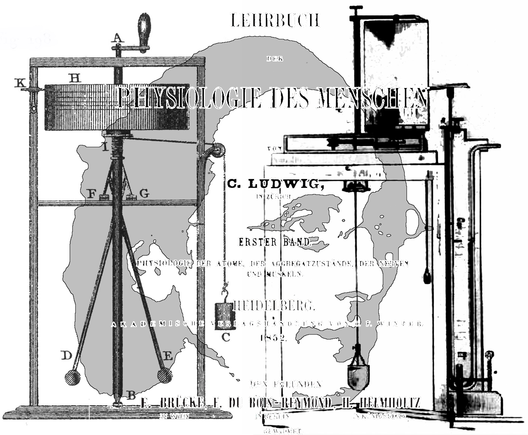Carl Friedrich Wilhelm Ludwig1816–1895
Of Ludwig’s many inventions the kymograph is the best known. It traces changes in physiological states over time. Ludwig’s features are traced in the illustration and a model of his kymograph is shown on the right: it consists of a recording stylus that can mark a rotating cylinder. He described it in 1847 as a way of measuring blood pressure over time. It has since been used for all manner of physiological and psychological recordings. A very similar devise, for measuring short intervals of time, was described at the beginning of the century by Thomas Young, and it is shown on the left. The text is the title page of Ludwig’s textbook on human physiology, published in 1852. Young’s lectures on natural philosophy and the mechanical arts, delivered in 1802, not only appreciated the importance of measuring short durations, but he also made an instrument: “by means of which an interval of a thousandth part of a second may possibly be rendered sensible”. A descending weight rotated a drum on which marks could be made by a pointer: “By means of this instrument we may measure, without difficulty, the frequency of the vibrations of sounding bodies, by connecting them with a point, which will describe an undulating path on the roller. These vibrations may also serve in a very simple manner for the measurement of the minutest intervals of time; for if a body, of which the vibrations are of a certain degree of frequency, be caused to vibrate during the revolution of an axis, and to mark its vibrations on a roller, the traces will serve as a correct index of the time occupied by any part of a revolution, and the motion of any other body may be very accurately compared with the number of alternations marked, in the same time, by the vibrating body”. Ludwig, together with Helmholtz, du Bois-Reymond, Schwann and Brücke, opposed the vitalistic views of their teacher, Johannes Müller, arguing in their stead that all phenomena of life can be accounted for in terms of physical.
